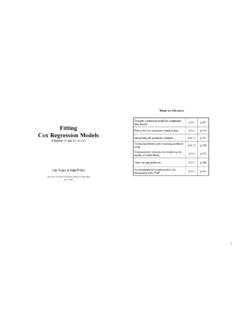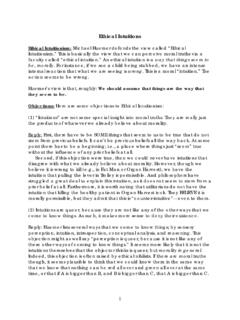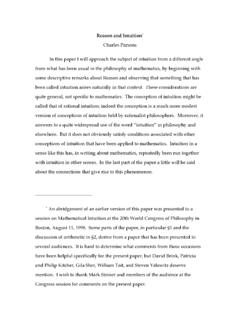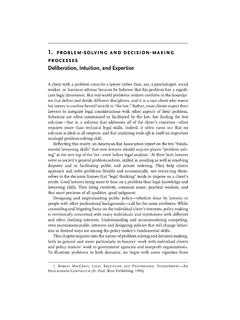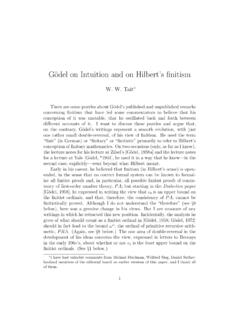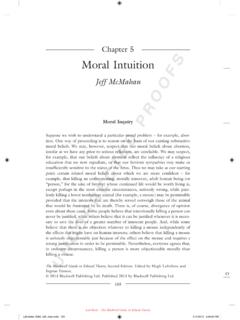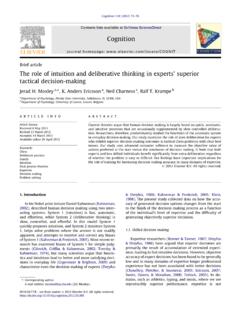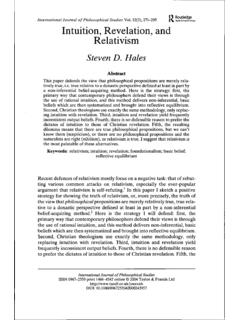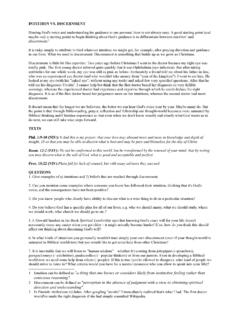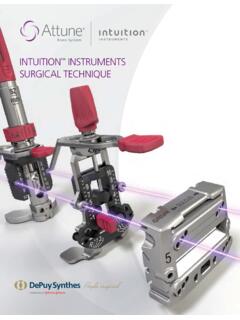Transcription of Mathematical Intuition1 Intuitive Mathematics: Theoretical ...
1 Mathematical Intuition1 Intuitive Mathematics: Theoretical and Educational ImplicationsTalia Ben-ZeevBrown UniversityJon StarUniversity of MichiganFebruary 5, 2002 Revised: 5/14/99 Comments and proofs should be sent to either Talia Ben-Zeev, Department of Cognitiveand Linguistic Sciences, Box 1978, Brown University, Providence, RI, 02912. or to Jon Star, Combined Program in Education and Psychology,1400 School of Education, University of Michigan, Ann Arbor, MI, 48109-1259; Intuition2 Intuitive Mathematics: Theoretical and Educational ImplicationsWhat kinds of intuitions do people have for solving problems in a formal logic system?Studies on Intuitive physics have shown that people hold a set of naive beliefs (Chi & Slotta,1993; diSessa, 1982,1993; McCloskey, Caramazza, & Green, 1980).
2 For example, McCloskey,Caramazza, and Green (1980) found that when people were asked to draw the path of a movingobject shot through a curved tube, they believed that the object would move along a curved(instead of a straight) path even in the absence of external forces. Such an Aristotelianconceptualization of motion, although mistaken, may be based in part on forming an analogy toreal-life examples, such as the Earth s circular movement around the sun (one does not see theforces that sustain such a movement).Does there exist a similar body of knowledge that we can refer to as intuitivemathematics? That is, can we identify a set of naive beliefs that are applied to solving abstractmathematics problems?
3 If so, how do these intuitions hinder or facilitate problem solving? Theanswers to these questions have implications for both psychology and education. By examiningthe nature of Intuitive mathematics we could help (a) improve our understanding of people sformal- and informal- reasoning skills and (b) create more effective instructional focus of much research, to date, has been on the development of early mathematicalcognition. A prime example comes from Rochel Gelman and colleagues ( , Gelman, 1979,1990; Gelman & Meck, 1983; Starkey, Spelke, & Gelman, 1990) work on implicit countingprinciples that enable pre-school children to understand and to perform addition.
4 In contrast,there has been much less emphasis on Intuitive understanding that develops as a result oflearning Mathematical procedures in later years. The largest lament on the part of the educationcommunity has been that an emphasis on learning procedures can lead to rote execution ofproblem-solving steps, resulting in lack of correct intuition for these procedures. For example,students often learn how to execute a procedure, such as multicolumn subtraction, withoutMathematical Intuition3understanding its underlying teleology (VanLehn, 1990). This finding has led to a proliferationof educational programs that emphasize the conceptual over the procedural ( , NCTM, 1989).
5 In this chapter, we will examine the nature and origin of what we term as symbolicintuition, or the Intuitive understanding of Mathematical symbols that develops as a result ofexperience with formal and abstract school-based procedures. Before we define more formallywhat we mean by intuition , in general, and symbolic intuition , in particular, we would like thereader to try and solve the following five problems, taken from a typical post-arithmeticmathematics curriculum:(1) How many lines pass through any given two points in 2-dimensional space?(2) A fair coin is flipped 10 times. The first 9 flips all come up heads. What isthe probability that the next, 10th toss, will come up heads?
6 (3) Which set has more members, the set of all rational numbers (numbers thatcan be expressed as one integer over another) or the set of all irrational numbers(non-repeating decimals)?(4) What is 8% of 142?(5) Solve for x: 3x + 7 = 19 Now, try and introspect about your experiences. To what extent did you have intuitionsabout solving these problems and what were they like? Most high-school students and adultshave correct intuition about the first problem (only one line can pass through two points in 2-dimensional space), incorrect intuitions about the second and third problems (erroneouslyassuming that there is a greater probability that the tenth toss will come up heads, and that allinfinities are alike, respectively) and no intuitions about the fourth and fifth problems becausecomputing percentages and solving polynomials can usually be done by employing procedureswithout understanding of the concepts involved.
7 We will return to discussing the correct,incorrect, and lack of intuitions for solving these specific problems in more detail later Intuition4In this chapter we seek to extend the work on the Mathematical cognition of pre-schooland elementary-school children to examining the symbolic intuitions that secondary-schoolstudents may have about problems such as the above. Do secondary school students havequalitatively different Mathematical intuitions, and if so, how are these intuitions developed? Asstudents move beyond the study of elementary arithmetic, what is the role of intuitions in theirmathematics learning? In the remainder of this chapter we will discuss the nature and origin ofcorrect and faulty intuitions in secondary school, in some detail, by identifying possible school-based and cognitive causes.
8 We will then provide some general prescriptions towards enhancingcorrect symbolic , however, we would like to present a more formal definition of intuition . The termintuition is used in a variety of ways by scholars in different disciplines (see Wild, 1936, for a listof 31 definitions of intuition ). Instead of listing each one, we divide intuitions according to twomain views, the classical and the inferential, based on their philosophical origins . We will thenintegrate these two viewpoints into our own conception of symbolic is Mathematical intuition ?The question of what exactly intuition is, in general, is relevant to a variety of domains,including philosophy, mathematics, psychology, and education (Westcott, 1968).
9 Philosophers,such as Bergson and Spinoza, have contrasted intuition with reason and logic, a view that can befound in some modern conceptualizations of Mathematical intuition to be discussed have traditionally regarded intuition as a way of understanding proofs andconceptualizing problems (Hadamard, 1954). Psychologists have examined the role of intuitivethinking in a variety of domains including clinical diagnosis, creativity, decision making,reasoning, and problem solving. A growing body of research in cognitive psychology has beendevoted to studying the process of insight, which is defined as a sudden understanding ofsomething, an Aha! experience, after a period of trying to solve a problem unsuccessfully ( , Mathematical Intuition5 Davidson, 1995; Gick & Lockhart, 1995; Seifert, Meyer, Davidson, Palatano, & Yaniv, 1995).
10 This literature views intuition as a phenomenon which primarily occurs through implicit andnon-analyzable processes. The psychological study of Mathematical intuition has been mainlyconducted in the area of statistical reasoning (see, for example, Tversky & Kahneman, 1974).This work shows that people are susceptible to a variety of biases, such as ignoring base-rateinformation in making probabilistic judgments. Finally, educators have been concerned with thequestion of how intuition affects the school-learning process. There has been recent focus ineducation on uncovering students pre-existing knowledge in order to make connections betweenschool-taught, formal knowledge, and students informal intuitions (Mack, 1990; Resnick, 1986).
